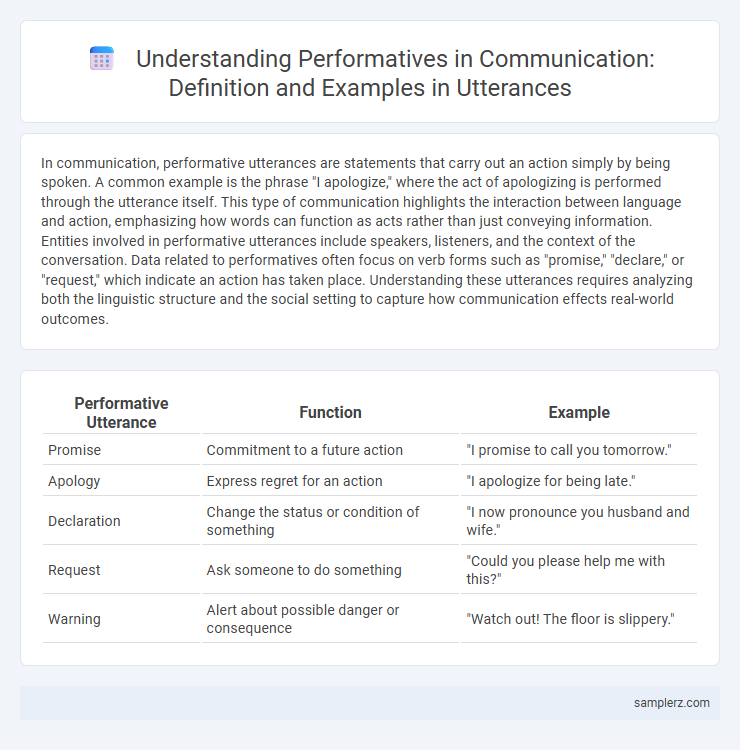In communication, performative utterances are statements that carry out an action simply by being spoken. A common example is the phrase "I apologize," where the act of apologizing is performed through the utterance itself. This type of communication highlights the interaction between language and action, emphasizing how words can function as acts rather than just conveying information. Entities involved in performative utterances include speakers, listeners, and the context of the conversation. Data related to performatives often focus on verb forms such as "promise," "declare," or "request," which indicate an action has taken place. Understanding these utterances requires analyzing both the linguistic structure and the social setting to capture how communication effects real-world outcomes.
Table of Comparison
| Performative Utterance | Function | Example |
|---|---|---|
| Promise | Commitment to a future action | "I promise to call you tomorrow." |
| Apology | Express regret for an action | "I apologize for being late." |
| Declaration | Change the status or condition of something | "I now pronounce you husband and wife." |
| Request | Ask someone to do something | "Could you please help me with this?" |
| Warning | Alert about possible danger or consequence | "Watch out! The floor is slippery." |
Understanding Performative Utterances in Communication
Performative utterances, such as "I apologize" or "I promise," perform an action simply by being spoken, directly influencing the communicative situation. These speech acts rely on contextual factors and speaker intentions to successfully enact commitments or declarations. Understanding performative utterances enhances effective communication by recognizing how language can function as action beyond mere information exchange.
Key Features of Performative Speech Acts
Performative speech acts are characterized by their ability to enact an action simply through the utterance itself, such as saying "I apologize" performs the act of apologizing. Key features include explicit performative verbs, first-person singular present tense, and the utterance resulting in a change in social reality. These acts rely heavily on context and speaker authority to be valid and effective in communication.
Common Everyday Examples of Performative Utterances
Performative utterances such as "I apologize," "I promise," and "I hereby declare" actively accomplish actions through speech. Saying "I apologize" not only expresses regret but enacts the apology itself, while "I promise" creates a commitment in communication. These speech acts demonstrate how language functions pragmatically to perform social actions beyond mere information exchange.
Performative Verbs: Defining the Action in Speech
Performative verbs like "promise," "apologize," and "declare" explicitly define the action being performed within an utterance by the speaker. These verbs transform statements into actions, such as when saying "I promise to attend," where the act of promising occurs through speech itself. Understanding performative verbs is essential in communication studies, as they highlight how language functions beyond mere information exchange to enact commitments or decisions.
Performative Utterances in Formal Settings
Performative utterances in formal settings include statements such as "I hereby pronounce you husband and wife" or "I apologize for the mistake," where the speaker's words enact an action. These utterances, identified by philosopher J.L. Austin, function not merely to convey information but to perform an act, often bound by social or legal conventions. In formal contexts like courtrooms, meetings, or ceremonies, performatives are crucial for executing decisions, conferring authority, or establishing commitments.
How Context Shapes Performative Meaning
In communication, performative utterances like "I apologize" or "I promise" directly enact the action they state, with their meaning heavily shaped by context such as speaker intention and social norms. The effectiveness of these performatives depends on factors like the relationship between interlocutors and the situational setting, which influence how the utterance is interpreted and received. Contextual elements determine whether a performative acts as a genuine commitment or a mere expression, highlighting the dynamic nature of language use in social interactions.
Cultural Variations in Performative Language
Performative language varies significantly across cultures, as certain speech acts like promises, apologies, or requests are constructed differently in terms of formality and directness. For instance, in Japanese, performative utterances often rely on honorifics and indirect expressions to convey politeness, contrasting with the more explicit and direct performatives found in English. Understanding these cultural variations is crucial for effective cross-cultural communication and avoiding misunderstandings in international contexts.
Challenges in Interpreting Performative Utterances
Understanding performative utterances presents challenges due to their reliance on context, speaker intention, and established social conventions, making interpretation highly situational. For instance, the phrase "I apologize" functions as an act of expressing regret only when uttered sincerely and under appropriate circumstances, but may be misinterpreted if context or tone is unclear. This ambiguity complicates natural language processing and human communication, requiring deeper pragmatic and semantic analysis to accurately decode performative meaning.
The Role of Intention in Successful Performative Acts
The role of intention in successful performative acts is critical, as it determines whether an utterance like "I apologize" or "I promise" effectively enacts the expressed action. Speech act theory highlights that performative utterances rely not only on linguistic form but also on the speaker's sincere intention to bring about a change in social reality. Without genuine speaker intention, the performative act risks being perceived as insincere or invalid, undermining communicative success.
Performative Utterances and Their Impact on Communication
Performative utterances, such as "I hereby declare" or "I apologize," directly enact the action they express, transforming communication from mere information exchange to action. These speech acts establish authority, create commitments, and influence social dynamics by performing actions through words. Understanding performative utterances enhances communication effectiveness by clarifying intentions and reinforcing social roles.

example of performative in utterance Infographic
 samplerz.com
samplerz.com